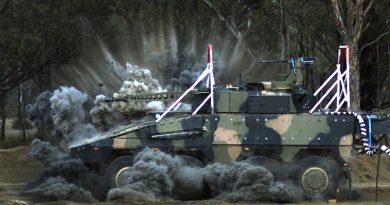Search continues for digger on Kapyong battlefield
Share the post "Search continues for digger on Kapyong battlefield"

An Australian Army soldier presumed to have been killed in the Korean War’s battle of Kapyong on April 24, 1951, is the subject of a new search by South Korea’s Ministry of National Defence (MND) and the ADF.
CAPTION: Adam Bourke, left, and Major Dan Nailer fix their position during a reconnaissance of the Kapyong battlefield in the Republic of Korea. Story and photos by Lieutenant Commander Brendan Trembath.
Twenty-two-year-old Corporal William Murphy, of 3rd Battalion, the Royal Australian Regiment (3RAR), was regarded as missing, killed in action.
On November 5, investigators from the MND Agency for Killed in Action Recovery and Identification (MAKRI), and Australia’s Unrecovered War Casualties – Army (UWC-A), conducted a reconnaissance of fighting pits on a steep peak in Gapyeong County where the soldier from Melbourne was last seen alive.
The pine tree-covered mountain, which is snowcapped in winter, resembles the high country outside Canberra.
Australian Army Major Dan Nailer, a case officer for Korean War Missing in Action, said the site inspection was a crucial step to familiarise themselves with an area they know intimately from terrain maps and historical accounts.
CAPTION: Major Dan Nailer, far left, and Adam Bourke, far right, accompany a Korean remains recovery team to the Kapyong battlefield in the Republic of Korea.
“As we are taught in the Army, nothing replaces time in reconnaissance; physically walking the ground and appreciating the terrain both from a tactical perspective as well as an archaeological perspective,” Major Nailer said.
To reach the peak, the recon team walked in the footsteps of 3RAR troops who had occupied defensive positions to halt a Chinese advance.
“It’s personally quite moving when you see and appreciate the difficulty of the terrain that the individual soldiers in the battle were fighting on,” Major Nailer said.
His colleague Adam Bourke, project manager Indo Pacific UWC-A, said retracing the steps of Korean War soldiers was phenomenal.
“It is quite surreal to be able to walk the ground where soldiers have actually fought in the war, and our main cause is obviously to try and identify our sole loss: Corporal Murphy,” Mr Bourke said.
MAKRI facilitated transport and access to the battlefield, which is alongside an active Army shooting range.
“It is not just from the logistics point of view but also safety and security. It’s been overwhelming the support MAKRI have been providing to UWC-A,” Mr Bourke said.
Major Nailer said the MAKRI members were outstanding hosts.
“They have provided us with three personnel who have personally hosted us and enabled us to get around physically, but also to understand some of the local context and get assistance from the local population as well, to help with our research efforts,” he said.
CAPTION: Major Dan Nailer, left, Adam Bourke and Captain Jordan Bell visit a Korean War monument at US Army Garrison Humphreys in Pyeongtaek, Republic of Korea.
.
.

.
.
Share the post "Search continues for digger on Kapyong battlefield"







